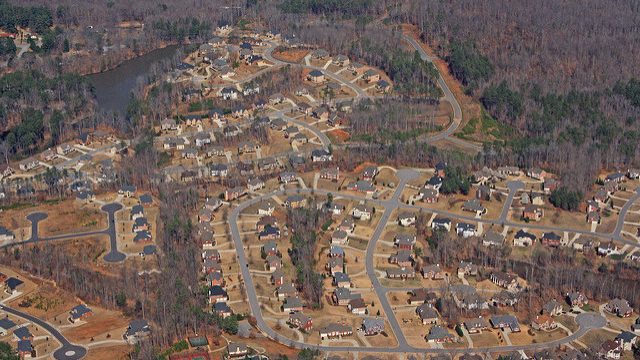New SE CASC publication: Landscape Connectivity Planning for Adaptation to Future Climate and Land-Use Change

A recent article, Landscape Connectivity Planning for Adaptation to Future Climate and Land-Use Change, describes a new analysis of habitat connectivity studies by SE CASC Researcher, Jen Costanza, and SE CASC Research Ecologist, Adam Terando. The following summary by Jen Costanza was published as a post on the Conservation Corridor website. The original post can be viewed here.
Review: climate change and land-use change as the biggest challenges to future connectivity
 Since the days of E.O. Wilson and Ed Willis, connecting habitats together has been recognized as one of the key pillars of conservation in landscapes dominated by human actions. But given the quickening pace of human-induced changes to the earth’s climate and land surface in recent years, it’s become increasingly clear that new thinking is needed when designing networks to improve habitat connectivity.
Since the days of E.O. Wilson and Ed Willis, connecting habitats together has been recognized as one of the key pillars of conservation in landscapes dominated by human actions. But given the quickening pace of human-induced changes to the earth’s climate and land surface in recent years, it’s become increasingly clear that new thinking is needed when designing networks to improve habitat connectivity.
For scientists and practitioners, a key question remains: which poses the biggest challenge for promoting habitat connectivity in the future? Climate change? Land-use change? Or both?
How that question is answered can have a big influence on which strategies are used to deal with the twin towers of global change. In our new paper, we review recent advances and challenges in the design of connectivity networks to address climate and land-use change. We also offer a practical conceptual framework for managers and other practitioners to consider when deciding between design options.
It’s evident from our review that more connectivity planning studies have integrated climate change than land-use change, and rarely do studies consider synergies between the two. This is probably due to a combination of factors, including the types of areas under study, the greater availability of climate model output, and the higher levels of uncertainty in land-use change models.
In reviewing this rapidly expanding literature, we found that successful strategies for promoting connectivity as a means to adapt to climate change and land-use change depend on two things: (1) the velocity of future climate change, or the distance necessary to travel in order to stay in a constant climate over time, and (2) the velocity of future land-use change, or the rate and degree of expected human modification.
Our conceptual framework distills these findings into a simple four-state matrix to demonstrate how understanding the pace of climate and land-use change can help narrow down the number of potential approaches and methods for promoting connectivity.

For example, in the protected areas of the Sierra Nevadas in California, low velocities of both land-use and climate change are likely for the next several decades. Here, a successful connectivity strategy could mean maintaining existing corridors and promoting ‘coarse-filter’ connectivity approaches such as the climate-gradient method, which minimizes climatic differences between habitats instead of distance between habitats.
In contrast, coarse-filter approaches will not work well in environments that are rapidly-changing but physically homogeneous. This includes regions like the Amazon Basin of Brazil, where relatively high velocities of both climate change and land-use change are likely. Here, ‘fine-filter’ approaches that model the sensitivity and exposure of target species and habitats to future climate and land-use change will be critical.
We also identified several challenges for connectivity planning in the future. One of the most daunting challenges is the high levels of uncertainty associated with models of future climate and land-use change. One promising approach to help deal with all this uncertainty is to assemble multiple connectivity models into an ensemble to better characterize a range of potential futures. Given these issues, it’s clear that scientists will have to rise to this challenge for conservation to be effective in this human-dominated age of rapid and climate and land-use change.
Resources
Costanza, J.K. and Terando, A.J. 2019. Landscape connectivity planning for adaptation to future climate and land-use change. Current Landscape Ecology Reports. DOI: 10.1007/s40823-019-0035-2. (Those without access may email the lead author at jkcostan@ncsu.edu.)
Nuñez, T.A., Lawler, J.J., McRae, B.H., Pierce, D.J., Krosby, M.B., Kavanagh, D.M., Singleton, P.H. and Tewksbury, J.J. 2013. Connectivity planning to address climate change. Conservation Biology 27(2): 407-16.
Meller, L., Cabeza, M., Pironon, S., Barbet‐Massin, M., Maiorano, L., Georges, D. and Thuiller, W. 2014. Ensemble distribution models in conservation prioritization: from consensus predictions to consensus reserve networks. Diversity and Distributions 20(3): 309-21.
Ordonez, A., Martinuzzi, S., Radeloff, V.C. and Williams, J.W. 2014. Combined speeds of climate and land-use change of the conterminous US until 2050. Nature Climate Change 4(9): 811-6.
Sohl, T.L., Wimberly, M.C., Radeloff, V.C., Theobald, D.M. and Sleeter, B.M. 2016. Divergent projections of future land use in the United States arising from different models and scenarios. Ecological Modelling 337: 281-97.
Wilson, E.O. and Willis, E.O. 1975. Applied biogeography. In M. L. Cody and J. M. Diamond [Eds.], Ecology and evolution of communities, pp.522-36. Harvard University Press, Cambridge MA.
Learn More
Related SE CASC Projects:
Turning the Science of Connectivity into Action: Finding Model Consistency and Identifying Priority Habitats for Conservation
Understanding Habitat Connectivity to Inform Conservation Decisions
Other Resources:
Fact Sheet on Wildlife Habitat Fragmentation by The Wildlife Society: Wildlife Habitat Fragmentation
A roadmap for assessing connectivity: LandScope America
- Categories:
